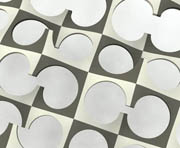8.1. Black/White - Left/Right. In his article “Weaving, Mother of Tensegrity” [5] Kenneth Snelson writes, and he illustrates it with a picture that is similar to Fig 42a: “Each woven interaction produces its rotational complement. Just as the individual crossings of filaments have their helical axes so each square in a plain weave has its opposite. Each cell’s neighbours are its mirror form like alternate squares on a chess board.” And this is exactly what is happening in the helical hole surfaces: neighbouring holes are each other’s mirror images. If one spiral hole is clockwise, his neighbour hole is counter clockwise. When we make this relation visible like in Figure 42d and 42e we can apply the soap film method again to create the surface shown in Figure 42f.



Figure 42a: Snelson
Figure 42b: Left/Right
Figure 42c: Black/White



Figure 42d: One hole
Figure 42e: First twist
Figure 42f: Helix



Figure 42g: Projecting
Figure 42h: Tiling
Figure 42i: Weaving


Figure 43: 3D weave square
Figure 44: 3D weave hexagonal